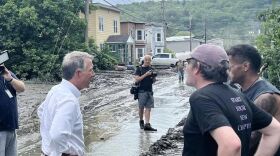A primary focus of Vermont Governor Phil Scott’s latest briefing Tuesday was infrastructure as the state moves toward the recovery stage after July’s flooding.
The rain has been relentless this summer in Vermont and Scott said new storms are still affecting the state. The Republican says the next few months will be focused on cleanup including debris removal and immediate infrastructure work.
“After we get through this phase heading into the fall, we need to be at a point where the conversation is more about recovery, mitigation work and revitalization," Scott said. "From my perspective, that means merging our flood recovery efforts and the community revitalization work we'd already begun using historic federal ARPA funds. As you know, we dedicated hundreds of millions to this work for things like housing, water, sewer, stormwater, infrastructure, climate change mitigation, economic development and more. Coordinating these efforts is how we can best build back stronger.”
Dealing with the debris from the flooding is among the state’s top priorities. Department of Public Safety Commissioner Jennifer Morrison reported that as of Monday 4,432 tons had been removed under a state contract, adding that the figure does not include debris that is being removed at the local level.
“Debris removal is a top priority right now and will be for the next few weeks," Morrison said. "In addition to the obvious areas related to high density neighborhoods and business districts, we want to locate and assist those who live on the outskirts or back roads and may need help with debris removal. Toward that end, we are working with six local emergency medical services agencies throughout the state to help prioritize and coordinate volunteer assistance for our most vulnerable citizens. These agencies will also be working with the Agency of Transportation to help identify overlooked flood debris and arrange for the removal of debris.”
Agency of Transportation Secretary Joe Flynn provided a report on repairs to state roads and infrastructure, including the Lamoille Valley Rail Trail. The sections from Swanton to Cambridge Junction and from St. Johnsbury to Walden are now open for public use, accounting for more than half of the 93-mile-long trail.
“The remaining 43.2 miles of the LVRT between Cambridge and Walden remain closed until further notice due to many different types of damage including complete bridge washouts, complete culvert wash outs and severe slope failures that are blocking the trail or have washed out the trail entirely," Flynn said. "All trail users must not access these areas due to active construction for your own safety. Although some areas appear passable, the surface and embankments may be compromised and could present unforeseen hazards.”
Prior to the flooding, Governor Scott had planned to bike the entire Lamoille Valley Rail Trail to celebrate what would have been the opening of the longest rail-trail in New England.
“It's difficult for the communities that were really counting on this to tie them together for their economic development," the governor said. "Personally, you know, it's discouraging but for them it could be devastating economically. Obviously, we wanted to make sure the road infrastructure was passable and we were putting all our resources there. But now we can move to another phase so that we can start rebuilding those sections.”
Addison County saw more flooding last Thursday and Friday. The county has not yet been included in the federal disaster declaration following the July flooding. Governor Scott urged residents to report damages to meet the FEMA threshold.
“We have had multiple, multiple systems that came in rapid fire after the initial event and created more damage," Scott said. "We are making the argument, and we'll continue to make the argument, that with the saturated soils that we have, that that's what's creating some of the impacts that we're seeing in Middlebury, Rutland, and so forth. By FEMA standards, we have to end it sometime and we may have to seek another declaration if we can meet that threshold.”
FEMA is still assessing damages from the storm. The deadline to apply for federal assistance is September 12.




















